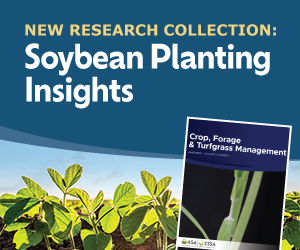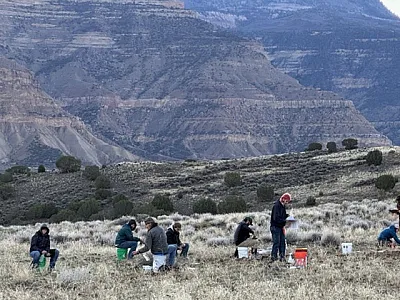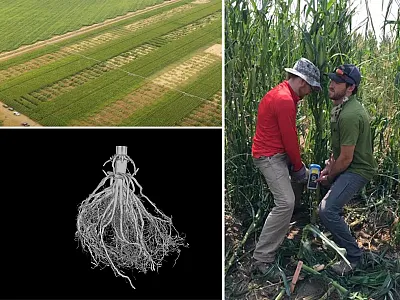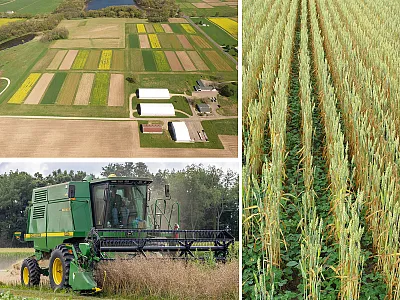Soil Physics and Hydrology: A Tribute to Rien van Genuchten
Special Section in Vadose Zone Journal Features Work Building on His Legacy

In 2023, ASA and SSSA Fellow Martinus “Rien” van Genuchten received the Wolf Prize in Agriculture “for his ground‐breaking work in understanding water flow and predicting contaminant transport in soils.” From the start of his career in the 1970s on, van Genuchten’s research has been instrumental in building hydrologists’ understanding of water and solute movement in unsaturated soils.
“I consider him almost like a godfather of the whole discipline,” says Jiří Šimůnek, a professor of hydrology at University of California–Riverside and a close collaborator of van Genuchten’s. “He developed a lot of the concepts which we are using … he developed these models to describe hydrologic properties and popularize a lot of approaches to describe flow and transport.”
Born in the Netherlands, van Genuchten grew up on a farm and studied at Wageningen University. He came to the United States for stints at New Mexico State University and Princeton University before establishing his research program at the University of California–Riverside and the U.S. Salinity Laboratory. There, van Genuchten and his colleagues worked on modeling preferential flow, improving analytical modeling and numerical solutions, colloid and colloid‐facilitated transport, alternative parameter optimization methods, the effect of water and solute stress on root‐water uptake and crop yield, improved descriptions of the soil hydraulic functions, and more. Today, the “van Genuchten” equations are used across simulations of subsurface flow.
Van Genuchten, a professor at The Federal University of Rio de Janeiro, Brazil, is the founding editor of Vadose Zone Journal (VZJ), which was established in 2002 “motivated by the recognition that the vadose zone is fundamental to many scientific and engineering disciplines.” And his 1980 Soil Science Society of America Journal paper, “A Closed‐Form Equation for Predicting the Hydraulic Conductivity of Unsaturated Soils,” presenting the Mualem‐van Genuchten equations to describe the relationship between the volumetric water content and the soil water potential in unsaturated soils, has more than 30,000 citations (https://bit.ly/3Wy74Y8).
In recognition of the Wolf Prize award and in tribute to van Genuchten’s scientific legacy, VZJ has recently published a special section in his honor. With 30 papers featuring work that builds off his many contributions to soil physics and vadose zone hydrology, including contributions from his collaborators, the section was published in the July issue of the journal. Here, we review three publications included in the special section and reflect on van Genuchten’s legacy.
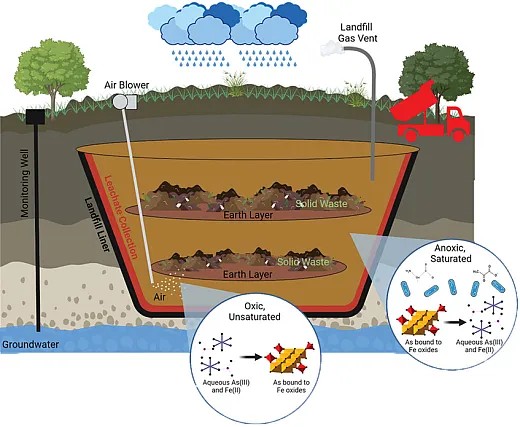
New Developments to HYDRUS Modeling Software
Ask almost any hydrologist—the HYDRUS software is an irreplaceable tool for studying water flow in the subsurface. HYDRUS is a Windows‐based software package that numerically simulates water, heat, and solute movement in variably saturated porous media, with a main focus on the vadose zone, and then displays obtained results graphically. “It simulates not only water flow, but also many additional processes such as root water uptake, transport of many different chemicals, carbon dioxide transport, heat transport, and so on,” says Šimůnek, a creator of the software.
The HYDRUS software package is based on a foundation of work published by van Genuchten and collaborators starting in the 1970s, including models describing simultaneous movement of water and solutes in variably saturated soils and in and below the root zones.
In the 1990s, Šimůnek, van Genuchten, and colleagues released HYDRUS‐1D, which simulated water flow and other processes in one‐dimensional porous media. It has been available in the public domain throughout its entire history. In 1996, the team released HYDRUS‐2D commercially for two‐dimensional modeling and combined it with 3D capabilities in 2007.
“Our main targets were ourselves, actually—to develop tools for ourselves and to make them as easily and quickly applicable as possible,” Šimůnek says of the initial production of and early additions to the software. “But then we started sharing that with the scientific community, and since then, their feedback [has been] very important for us for what processes to add, how to make it easier for them to use, and how to prevent … mistakes,” Šimůnek says.
Over the years, Šimůnek and colleagues have reviewed these additions to the HYDRUS package, as well as novel uses of the software, in several articles in VZJ. In the special section, the researchers outline additions made to the software since their last review (https://doi.org/10.1002/vzj2.20310). In 2022, the 1D, 2D, and 3D capabilities were merged into the fifth version of the software, simply called HYDRUS. New add‐on modules are now available that provide users with augmented modeling capabilities, including modeling general and specific reactive transport of chemicals, and to account for preferential flow and colloid‐facilitated solute transport. Of particular importance, Šimůnek notes, is a new module for accounting for the transport and fate of per‐ and polyfluoroalkyl substances (PFAS) in the vadose zone.
Still today, Šimůnek leads courses across the globe to train new users on the ins and outs of HYDRUS, often with van Genuchten himself. “We joke that we are like two missionaries going to all these different continents,” Šimůnek says of their efforts. Their pupils include graduate students, professors, and consultants and others from industry. HYDRUS’ impact is borne out in the numbers: More than 3,000 institutions and companies use the commercial version of HYDRUS worldwide, and the public version of HYDRUS‐1D has likely tens of thousands of users.
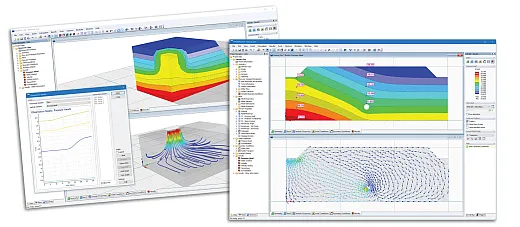
New Functions to Calculate Root Water Uptake
Also in the special section are articles that build off van Genuchten’s work on soil water dynamics. In the vadose zone, water uptake by plant roots plays a principal role in maintaining the soil’s delicate moisture balance. “When there is not sufficient water in the soil anymore or when the soil dries out, the water becomes more and more tightly bound to soil particles due to capillary forces, then it gets harder for the plant to extract that water,” explains Jan Vanderborght, a professor at Forschungszentrum Jülich in Germany.
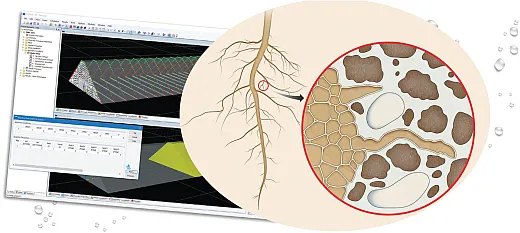
Researchers need to understand and predict root response to water stress when evaluating crop sensitivity to drought. Many models, including HYDRUS, use an approach that models root water uptake as a function of the soil water potential—a relationship is set up between the actual amount a root system can extract and the amount the plant would extract if sufficient water was available. As long as there is no water stress, of course, that ratio equals 1. But when the soil dries out, the ratio drops below 1 and eventually to 0.
These functions require the assumption that soil water potential in the root zone is uniform. This makes things complicated, Vanderborght says, as the water in the root zone is not homogeneously distributed; when it rains, more water sits on the top of the root zone. “What can happen then is that plants can take up more water from layers that are wet than layers that are dry, so that is called root water uptake compensation.”
In their paper, “Mechanistically Derived Macroscopic Root Water Uptake Functions: The α and ω of Root Water Uptake Functions,” published in the special section, Vanderborght and his co‐authors developed a new concept with which to define the functions that describe how root water at a certain depth decreases with the soil water potential and those that describe how roots can compensate.
“In the past, these functions were derived from empirical observations. But the problem with those observations is that you typically can measure only the transpiration from the plants and an average moisture content in the root zone,” Vanderborght explains. “There is a mismatch between what is measured on the one hand and what is then used in simulation models to simulate the root water uptake on the other hand.” Another inadequacy with the models is that they don’t consider the effect of soil type on the functions. “We know that the same variety of crop can develop completely different root systems in different soils,” he says.
The researchers started with a mechanistic model—one in which they consider water potential differences between soil and root system and within root system itself—that simulates the flow in the soil and root system. Based on these coupled models, they could describe root water uptake mechanistically, rather than empirically. In other words, “instead of having to do experiments and to parameterize these functions, we can derive these functions directly from information about the soil hydraulic properties, the roots, and root system properties,” Vanderborght says.
The researchers are now testing how well the model works against real experimental observations, including soil moisture measurements and soil and water potential measurements. Other groups are developing new sensors for measuring leaf water potentials more accurately, Vanderborght notes, data from which will help them continue to test their models.
Going forward, the models will help scientists better predict crop response to climatic changes, develop new or improved drought‐tolerant varieties, and guide management practices. With this work, “[we’re] making a nice link between soil physics on the one hand and crop science on the other,” Vanderborght says.
Mentorship and Modeling Preferential Flow
With authorship from many of van Genuchten’s former students, many papers in the special section serve as testaments to his legacy as a mentor. One is “Characterizing Large‐Scale Preferential Flow Across Continental United States” (https://doi.org/10.1002/vzj2.20316) by Texas A&M University Ph.D. student Leah Kocian and Texas A&M University professor Binayak Mohanty, a former advisee of van Genuchten’s.
When COVID hit in 2020, Kocian was hard at work in the field and the lab trying to measure a phenomenon called preferential flow. That all quickly went down the drain when the opportunities for in‐person work dried up. “We had to come up with another way to try to continue pursuing the project because we thought we had a really good idea, but we needed a new way to either get data … or to measure it,” she says.
Preferential flow describes the uneven rapid flow of water through the soil matrix via pathways of large soil pores or fractures, rather than uniform flow through smaller pores. “The flow processes that happen through those larger pores don’t necessarily follow … capillary theory,” explains Mohanty, editor of the special section. Intense precipitation can drive these preferential flow events and lead to the rapid recharge of shallow groundwater within 5 m of the soil surface.
Any potential contaminants in this rapid flow of water can’t attach to the soil and thus bypass the soil’s natural filtration function, Kocian adds. “Then if it does transport closer and closer to groundwater or even reach [the] groundwater table, you have this exposure pathway.”
Historically, preferential flow has been empirically studied on local scales that only capture a snapshot of the phenomenon. But when looking at the real‐world impact of preferential flow, for example when determining its impact on groundwater contamination, a larger scale of study is needed. “If we limit ourselves only to a point scale or a local scale, we don’t capture the big picture story that might be contributing because of many co‐existing preferential flow features,” Mohanty continues.
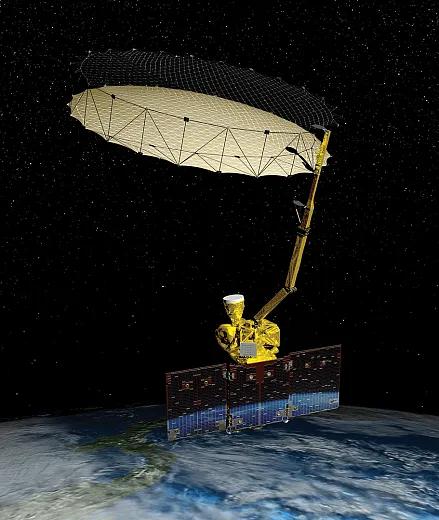
With COVID came a silver lining research opportunity, Kocian explains. Why not use remote‐sensing data, safely and available to the researchers and collected over a far‐reaching scale, to assist in estimating effective preferential flow across the continental United States? They obtained soil moisture data at 9‐km resolution from NASA’s Soil Moisture Active Passive (SMAP) satellite, which orbits the Earth measuring soil moisture. To account for effective preferential flow at large landscapes or satellite footprints, they brought together surface soil moisture data from SMAP, groundwater table data from USGS, and precipitation data from CHIRPS (a precipitation data set) for sites across the continental U.S. between 2019 and 2021.
“While I was trying to model preferential flow, I was finding it was really difficult to get just a table of hydraulic properties in the soil that describe this process at large scale for various soil textures,” Kocian reflects. This experience “enlightened” their next steps, she says. Using the dual‐porosity model published by Gerke and van Genuchten in 1993 and implemented in HYDRUS‐1D model, Kocian took an inverse modeling approach with the data. The model can simulate preferential flow with equations describing variably saturated water flow in the soil matrix and the macropore system as well as solute transport and transfer of water and solute between these two regions.
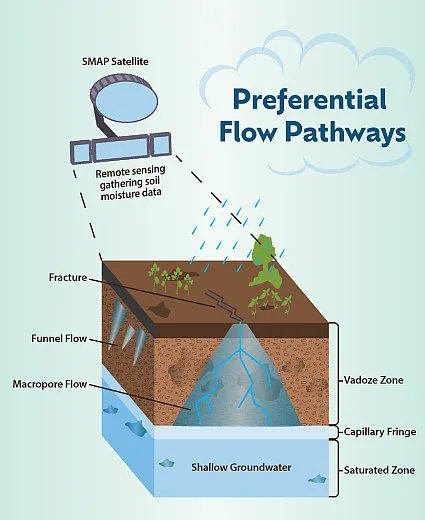
“In the model, we already knew precipitation, soil texture, groundwater values over time … from 2019 to 2021. And so, with an inverse modeling approach, we can estimate the soil hydraulic properties specific to preferential flow,” Kocian says—in simple terms, using a and y in a+b = y to find b. Once they had their table of soil hydraulic properties (the “b” values), they confirmed these values at four new sites with matching soil textures using shallow groundwater table data from USGS, running the model forward this time with those data plugged in.
Kocian then established three benchmarks with which to determine if these events represented effective preferential flow: if daily precipitation was greater than or equal to the site’s average precipitation, if the shallow groundwater level increased, and if the modeled and observed shallow groundwater table was less than or equal to the root mean square error for that site. “We said all three of these criteria have to be met for us to be confident enough to say that this particular day had a preferential flow event,” Kocian says.
Finally, the researchers combined these confirmed events with the modeling parameters and data to train a random forest algorithm to predict large‐scale preferential flow events with 98% accuracy. As the modeling includes parameters for specific soil textural classes, they confirmed the analysis can be transferred to other locations with similar soil classes. “The beauty of this work is the transferability,” Mohanty says.
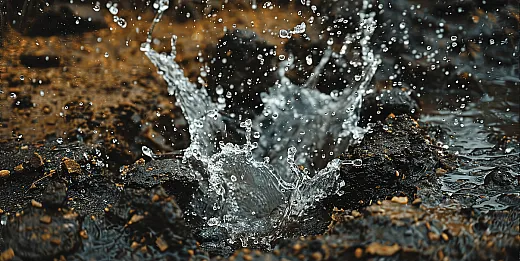
Kocian and Mohanty hope to see future work address some of the study’s limitations, such as adding multidimensional flow and consideration of the influence of vegetation to the analysis. In the meantime, the work represents a crucial step towards addressing the challenges posed to water quality by preferential flow events. And in the future, Mohanty hopes to see more studies of soil and the vadose zone specifically take advantage of remote‐sensing data. “Remote sensing is exploding in the last 20 to 30 years, but our agricultural community and soil science have not taken advantage of those capacities as much as we can.”
DIG DEEPER
Rien van Genuchten has made a deep impact on soil science. You can find the tribute special section in Vadose Zone Journal here: https://bit.ly/3YdjiXh.
Specific papers from the special section mentioned in this article include:
Šimůnek, J., Brunetti, G., Jacques, D., van Genuchten, M. Th., & Šejna, M. (2024). Developments and applications of the HYDRUS computer software packages since 2016. Vadose Zone Journal, 23, e20310. https://doi.org/10.1002/vzj2.20310
Vanderborght, J., Couvreur, V., Javaux, M., Leitner, D., Schnepf, A., & Vereecken, H. (2024). Mechanistically derived macroscopic root water uptake functions: The α and ω of root water uptake functions. Vadose Zone Journal, 23, e20333. https://doi.org/10.1002/vzj2.20333
Kocian, L., & Mohanty, B. P. (2024). Characterizing large‐scale preferential flow across Continental United States. Vadose Zone Journal, 23, e20316. https://doi.org/10.1002/vzj2.20316
And check out Rien van Genuchten’s autobiography here: https://doi.org/10.1002/vzj2.20322
Text © . The authors. CC BY-NC-ND 4.0. Except where otherwise noted, images are subject to copyright. Any reuse without express permission from the copyright owner is prohibited.




